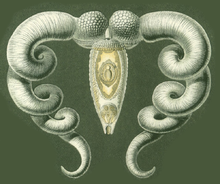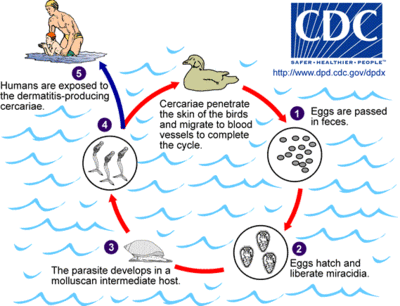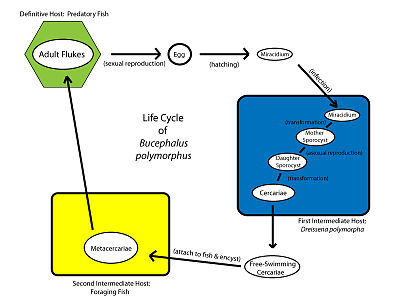- Trematode lifecycle stages
-
Trematodes are small parasitic flatworms that use vertebrates as their definitive host, and molluscs as their intermediate host. In order to accomplish this, they have several varied lifecyle stages.
The lifecycle of a typical digenean trematode can be thought to begin when its egg is immersed in water. Following this a miracidium hatches, which swims to find a mollusc host. The miracidia go through several stages in the mollusc host, eventually emerging as motile cercaria larvae.[1] The cercaria infect vertebrates either through the skin or are ingested. In its vertebrate host, the cercaria matures to an adult form, and lays eggs that are discharged with the host faeces or urine. In the presence of open water, the eggs will hatch and the miracidium stage of life is reached again.
Contents
Typical lifecyle stages
 Bucephalid cercaria larva from Ernst Haeckel's Kunstformen der Natur (1904) The tail's furcae give the impression of horns, hence the genus name "Bucephalus" meaning "ox head."
Bucephalid cercaria larva from Ernst Haeckel's Kunstformen der Natur (1904) The tail's furcae give the impression of horns, hence the genus name "Bucephalus" meaning "ox head."
While the details vary with each species, the general lifecycle stages are as follows:
- Egg – discharged either in open water or in mollusc intestine.
- Miracidia – free-living motile form, covered with cilia, which settles in the mollusc to become a sporocyst.[2]
- Sporocyst – an elongated sac that produces either rediae or more sporocysts.[3]
- Redia (plural rediae) – a larval form with an oral sucker, it will produce either more rediae, or cercariae.[3]
- Cercaria (plural cercariae) – the larval form of the parasite, developed within the germinal cells of the sporocyst or redia.[3] A cercaria has a tapering head with large penetration glands.[2] It may or may not have a long swimming "tail", depending on the species.[3] The motile cercaria finds and settles in a host where it will become either an adult, or a mesocercaria, or a metacercaria, according to species.
- Mesocercaria – a cercaria little modified but resting.
- Metacercaria – a cercaria encysted and resting.
- Adult – the fully developed mature stage, capable of sexual reproduction.
Deviations from the typical lifecycle
The typical sequence (eggs, miracidia, sporocysts, rediae, ceracariae, and adults) is by no means the rule for all trematode species. In some species the redia stage is omitted and sporocysts produce cercariae. In some species, the cercaria develops into an adult within the same host.
Many digenean trematodes require two hosts, one (typically a snail) where asexual reproduction occurs in sporocysts, the other a vertebrate (typically a fish) where the adult form engages in sexual reproduction to produce eggs. In some species (for example Ribeiroia) the cercaria encysts, and waits until the host is eaten by a third host, in whose gut it emerges and develops into an adult.
Most trematodes are hermaphroditic, but members of the family Schistosomatidae are dioecious. Males are shorter and stouter than the females.[2]
Representations of lifecycles of several different trematode species
 Lifecycle stages of a digenean human parasite, Schistosoma japonicum.
Lifecycle stages of a digenean human parasite, Schistosoma japonicum.
 Lifecycle stages of trematode species that cause "swimmer's itch".
Lifecycle stages of trematode species that cause "swimmer's itch".
References
- ^ "2. FISH DISEASES (Contd.) 2.1.4 Parasitic Diseases". FAO of the UN Food and Agriculture Organization of the United Nations. http://www.fao.org/docrep/field/003/ac160e/AC160E03.htm. Retrieved 18 February 2011.
- ^ a b c "Schistosoma". Australian Society for Parasitology. http://parasite.org.au/para-site/text/schistosoma-text.html. Retrieved 19 February 2011.
- ^ a b c d "Glossary". VPTH 603 Veterinary Parasitology. University of Pennsylvania School of Veterinary Medicine. http://cal.vet.upenn.edu/projects/parasit06/website/glossary.htm.
See also
- Bucephalus polymorphus
- Trematode infection
- Apicomplexa lifecycle stages
External links
Categories:- Flatworm stubs
- Parasite stubs
- Digenea
Wikimedia Foundation. 2010.


